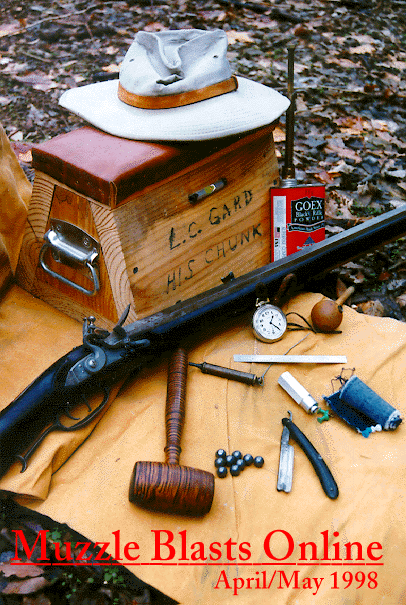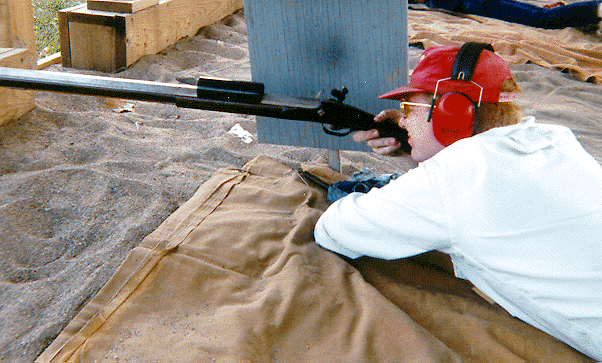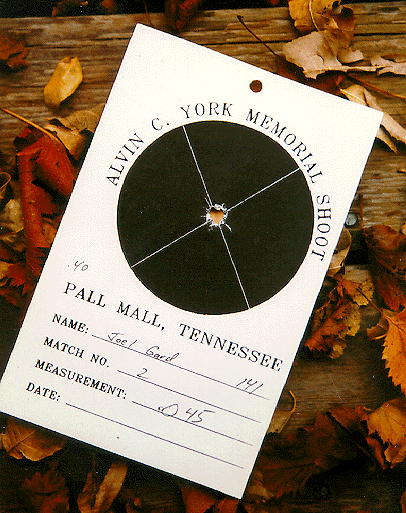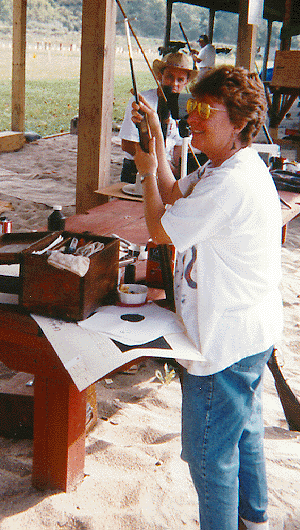|
Muzzle Blasts Online |
|
...for the muzzleloading enthusiast |
|
The muzzleblasts.com domain, subdomains, content, etc., are neither affiliated with the NMLRA nor its paper magazine Muzzle Blasts |
|
Muzzle Blasts Online |

|
|
|
|
|
|
Chunk 101: An Introduction to Over-the-Log Match Shooting
The following excerpts are taken from Sketches and Eccentricities of Col. David Crockett of West Tennessee, published in London in 1834. The author describes a Tennessee shooting match of 1831 involving Mr. Crockett. "Forty yards offhand, or sixty with a rest, is the distance generally chosen for a shooting match. If no distance be specified, this is implied. In all their shooting matches, no ball is allowed to count which is not found within an inch. They use for patching, cotton cloth, and wipe their rifles after every discharge. The place selected was a grove, near which stood a tippling house. We found many persons already assembled, and they continued to flock in until several hundred were collected. Each man who was to shoot carried with him his target; this consisted of a small board which had been burned black, on which a small piece of white paper had been pinned [as a spotter]. There was no regularity in shooting: each marksman called for his target when it suited him."
The direct descendant of that form of match shooting is found on the chunk gun line at Friendship every Spring and Fall, and at many smaller shoots all over the country every year. The heart of the match, and the source of the name "Chunk Gun" comes from the use of a rest, or "chunk", in the prone position. The chunk can be anything from a piece of firewood to a carefully made box or multi-level shooting stand, as the shooter's individual taste and imagination may dictate. Sixty yards is the regulation distance between shooter and target.
The rules are generally simple. You can use any rifle of any weight and of any caliber provided that it has fixed open sights. False muzzles are not allowed, and many matches restrict the rifles used to those of a traditional style. Shaders are allowed over the open sights at the Friendship matches and at most other matches. Windage and elevation adjustments are accomplished by the use of spotters, which are individually supplied targets that overlay the "X" center targets provided for scoring.

|
|
Percussion ignition seems to be favored by most chunk shooters |
"So, how do I shoot a Chunk Gun match?" you might ask. You start by posting a practice target or a "spotter" target if you have prepared one in advance of the first relay. Shoot several shots into the practice target until you get a good consistent group that you think you can repeat on your record match. That practice target becomes your spotter for the next relay. For your record relay, with your spotter in hand, proceed to tack up your record target. Now put your spotter over the record target so that the "X" is sitting right in the middle of your practice target group. It doesn't matter where your group is on the practice target (high, low, left, right, etc.) just so that you put the record "X" in the middle of the group and then continue to hold the same sight picture when you shoot the next relay. Because your sights are fixed, you don't make sight adjustments for wind or light-you move the spotter instead.
Now that seems simple enough, but it's harder than you might think. For one thing, you can't move your spotter in the middle of a relay like you can adjust your sights on a bench gun. You either have to hold off target and allow Kentucky windage, or just stick with where you put your spotter and hope the wind or light comes back to where it was when you started.
Chunk shooters generally fall into two groups when it comes to spotter placement-Leave-Its and Chasers. Leave-Its will post a target, place their spotter over the "X" and leave it there all day, shot after shot, relay after relay, day in and day out. The idea there is that, if you are paying attention to your shooting, a particular gun shoots to the same point of aim every time you touch the trigger. And in theory, that is generally true. The trouble with the Leave-Its' theory is that it doesn't allow for changes in wind or light or ground conditions that can affect the way the shooter sees the target or how the ball travels on the way to the target or how the shooter holds the rifle from shot to shot while lying on the varying levels of ground found along any chunk line.
Chasers, on the other hand, will continue to move the spotter to the place where the last shot landed, on the theory that the last shot fired is where the next one will go. Chasers will spend most of a day "chasing" the last shot around the target, hoping to get lucky and catch three balls in a row in the same spot. The trouble with the Chaser method is that it assumes that every shot is a valid one and that it accurately predicts the outcome of the equation of variables of trajectory, wind, light, and hold for each successive shot. A wild shot caused by a gust of wind or a cloud moving over the target or a bad hold will send a Chaser moving the spotter all over the paper hoping to establish a "group", and thus shrink the ever-lengthening string measure.

|
|
|
As is true in any shooting game, consistency is the key to success with chunk guns. On the Walter Cline Range, relays tend to be longer than is usually needed to carefully fire three record shots. The long relays are dictated by the placement of the chunk line in between the silhouette and bench lines, both of which require the longer forty-five minute relays to fire their shots. That long relay can be a blessing and a curse. The blessing is that you have plenty of time to load your rifle carefully and precisely and hold for the perfect wind to get off three record shots. The curse is that light and wind conditions can easily change two or three times in forty-five minutes, and you can't adjust your sights or the spotter to accommodate those changes during the relay.
Chunk shooting also poses problems in establishing and maintaining a consistent shooting position from shot to shot and relay to relay. The match is fired from the prone position over a rest. For each shot you have to get down on the ground to shoot and then get back up to reload. Every time you leave your shooting position, you have to reestablish it for the next shot. Now that's no different from any other kind of muzzleloading shooting, but with offhand or bench shooting you aren't making quite the degree of readjustment between shots as with chunk shooting. The problem is amplified if the shooter uses a particularly heavy rifle that is hard to maneuver in and out of position for every shot. A failure to maintain consistency in your shooting position from shot to shot will result in fliers caused by canting the barrel and variations in sight picture caused by placing your face in a different position on the stock relative to the sights. It takes many hours of practice and familiarity with your rifle to control these variables. The chunk shooting game is quite challenging and much more demanding than may be apparent to the casual observer behind the line.

|
|
Sandi Swanson, a regular chunk gun competitor |
To learn more about chunk shooting, read The Muzzleloading Rifle Then and Now, by Walter Cline and Muzzleloading Shooting and Winning with the Champions, both available from the NMLRA bookstore. Or just stop by the chunk gun line any day during the Spring and Fall matches; there is always somebody around there willing to talk about the game and show you how to get started.